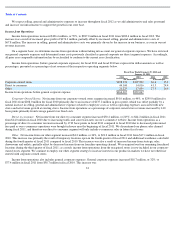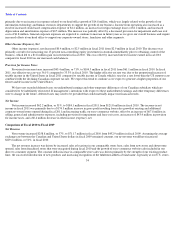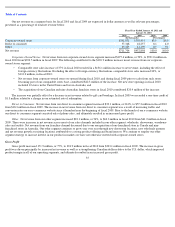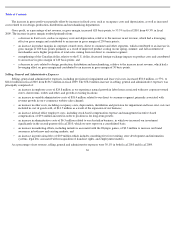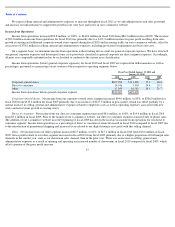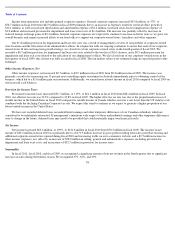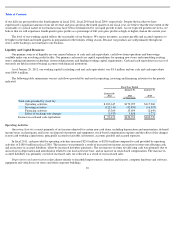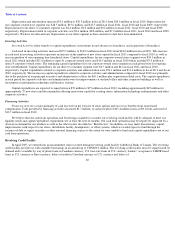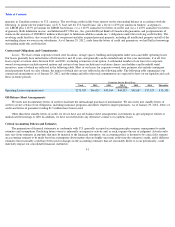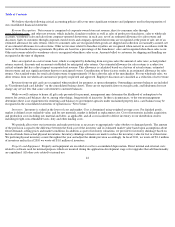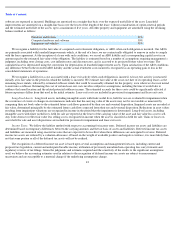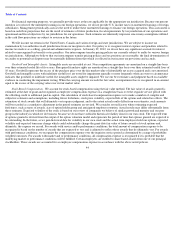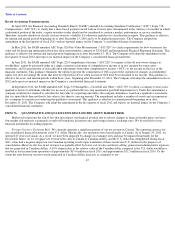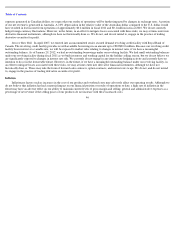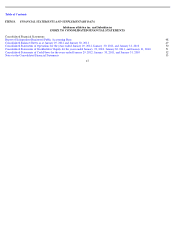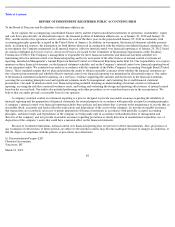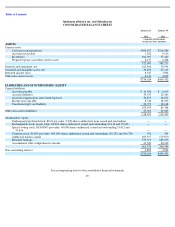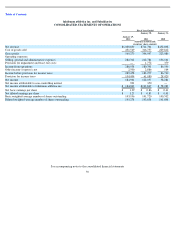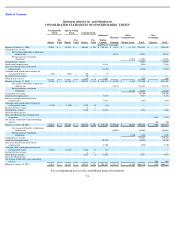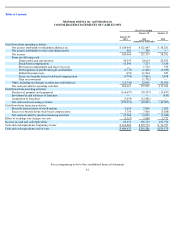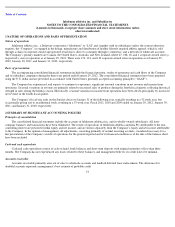Lululemon 2011 Annual Report Download - page 46
Download and view the complete annual report
Please find page 46 of the 2011 Lululemon annual report below. You can navigate through the pages in the report by either clicking on the pages listed below, or by using the keyword search tool below to find specific information within the annual report.
Table of Contents
software are expensed as incurred. Buildings are amortized on a straight-line basis over the expected useful life of the asset. Leasehold
improvements are amortized on a straight-line basis over the lesser of the length of the lease, without consideration of option renewal periods
and the estimated useful life of the assets, up to a maximum of five years. All other property and equipment are amortized using the declining
balance method as follows:
We recognize a liability for the fair value of a required asset retirement obligation, or ARO, when such obligation is incurred. Our AROs
are primarily associated with leasehold improvements which, at the end of a lease, we are contractually obligated to remove in order to comply
with the lease agreement. At the inception of a lease with such conditions, we record an ARO liability and a corresponding capital asset in an
amount equal to the estimated fair value of the obligation. The liability is estimated based on a number of assumptions requiring management’s
judgment, including store closing costs, cost inflation rates and discount rates, and is accreted to its projected future value over time. The
capitalized asset is depreciated using the convention for depreciation of leasehold improvement assets. Upon satisfaction of the ARO conditions,
any difference between the recorded ARO liability and the actual retirement costs incurred is recognized as an operating gain or loss in the
consolidated statements of operations.
We recognize a liability for a cost associated with a lease exit activity when such obligation is incurred. A lease exit activity is measured
initially at its fair value in the period in which the liability is incurred. We estimate fair value at the cease-use date of its operating leases as the
remaining lease rentals, reduced by estimated sublease rentals that could be reasonably obtained for the property, even where we does not intend
to enter into a sublease. Estimating the cost of certain lease exit costs involves subjective assumptions, including the time it would take to
sublease the leased location and the related potential sublease income. The estimated accruals for these costs could be significantly affected if
future experience differs from that used in the initial estimate. Lease exit costs are included in provision for impairment and lease exit costs.
Long-Lived Assets. Long-lived assets, including intangible assets with finite useful lives, held for use are evaluated for impairment when
the occurrence of events or changes in circumstances indicates that the carrying value of the assets may not be recoverable as measured by
comparing their net book value to the estimated future cash flows generated by their use and eventual disposition. Impaired assets are recorded at
fair value, determined principally by the estimated future cash flows expected from their use and eventual disposition. Reductions in asset values
resulting from impairment valuations are recognized in income in the period that the impairment is determined. Long-lived assets, including
intangible assets with finite useful lives, held for sale are reported at the lower of the carrying value of the asset and fair value less cost to sell.
Any write-downs to reflect fair value less selling cost is recognized in income when the asset is classified as held for sale. Gains or losses on
assets held for sale and asset dispositions are included in provision for impairment and lease exit costs.
Income Taxes. We follow the liability method with respect to accounting for income taxes. Deferred income tax assets and liabilities are
determined based on temporary differences between the carrying amounts and the tax basis of assets and liabilities. Deferred income tax assets
and liabilities are measured using enacted tax rates that are expected to be in effect when these differences are anticipated to reverse. Deferred
income tax assets are reduced by a valuation allowance, if based on the weight of available positive and negative evidence, it is more likely than
not that some portion or all of the deferred tax assets will not be realized.
The recognition of a deferred income tax asset is based upon several assumptions and management forecasts, including current and
proposed tax legislation, current and anticipated taxable income, utilization of previously unrealized non-operating loss carry forwards and
regulatory reviews of tax filings. Given the judgments and estimates required and the sensitivity of the results to the significant assumptions
used, we believe the accounting estimates used in relation to the recognition of deferred income tax assets are subject to measurement
uncertainty and are susceptible to a material change if the underlying assumptions change.
43
Furniture and fixtures
20
%
Computer hardware and software
30
%
Equipment and vehicles
30
%


